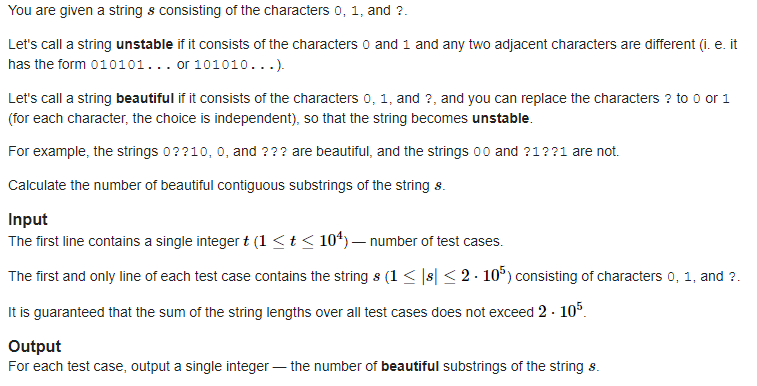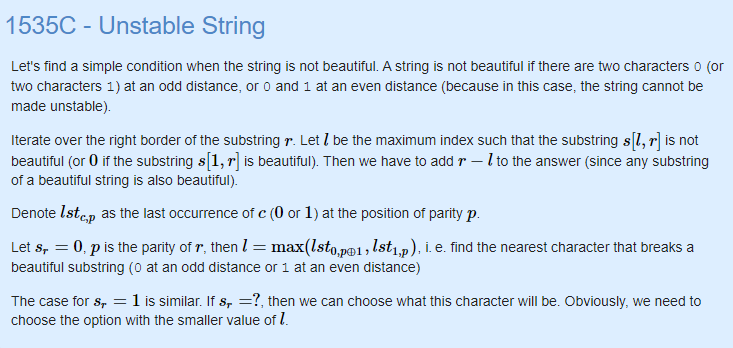Codeforces 1535C - Unstable String
条评论题意

思路
拿到这题之后,注意到这题算是一个计数题,要求我们计算出所有$beautiful$的$substring$。
遇到关于$substring$的题目,考虑一下子串的性质与子串的子串是否会有联系。
发现在本题中,如果某一子串是$beautiful$的,那么,它的所有子串也是$beautiful$的。
由此,可以考虑这么一种算法:
- 从某一位置出发,找到最长能够到达的位置使得这个串是$beautiful$的
- 若这个$beautiful$的串长度为$len$,则可以对答案增加$len * (len + 1) / 2$的贡献。
- 设这个串的末尾位置为$pos$,如果$str[pos]=?$,则以$pos+1$为起点寻找下一个能够到达的最长位置。
- 如果不为$?$,则考虑$1010??? \dots ??[?]$的情形,其中$[?]$对应位置$pos$,我们可以回退到连续的$?$中的第一个$?$,便于改变$?$对应的值以达到更长的能够到达的位置。
这里我们可以类比$Manacher$算法,知道当前已经计算到的最长可到达位置是单调不减的,因此理论上这个算法写出来是接近$O(N)$的。
代码实现如下:
1 | /* vegetable1024 | oi-liu.com | Maybe Lovely? */ |
那么,这个算法是否是正确的呢?
事实上并不,主要问题出现在当前拓展到的最远位置为$?$时,回退操作该回退到什么位置,才能够【不重不漏】。
比如:
1 | 1 |
这组数据就能够把我卡掉。每次拓展寻找的段信息如下:
1 | debug: lf:1 rt:2 len:2 delta_ans:1 |
可以发现,按照上面的思路进行拓展,最后$[0??]$这一段会被忽略掉,不被计算,只计算了$[??]$这一段。
因此,这个算法是存在一个相当大的问题的。
如果我们直接计算了$[0??]$这一段,然后跳到$??$后的第一个位置,则可能会使得后面的某些串贡献减少。
如果我们直接往前拓展,找到不满足$[…0??]$的最长一段,那么就需要处理与前面计数的重复问题。
由于这两个问题我都没能解决,因此这个算法理论上可以,但实际上没能写出来。
后面学习题解,有一个很简练的$dp$做法。
1 | //Codeforces @kj1809 |
核心思想是设置$dp[i][0/1]$,代表位置为$i$且结尾为$0/1$的合法字符串数目。如果$i-1$位是$1$,则$dp[i][1]$直接置为$0$,因为子串是连续的,而两个相邻的$1$是不$beautiful$的。由此便可以进行转移。
而官方题解为我们提供了关于这道题奇偶性的一个讨论。

1 | //Codeforces @Neon |
结尾
我倒是想把我那个做法写出来…
但是一直找不到一种可以【不重不漏】的解法(
理论上我可以再预处理反向能够拓展到的最大距离,然后开一个$bool$数组记录那些会重复,每次一边加一边减(
有读者看到的话,可以帮我想一想简便写法(
非常感谢QAQ